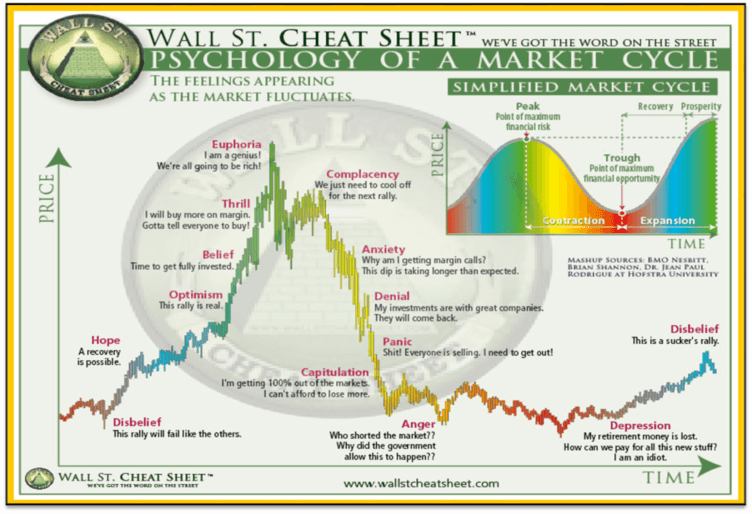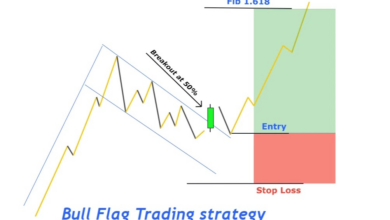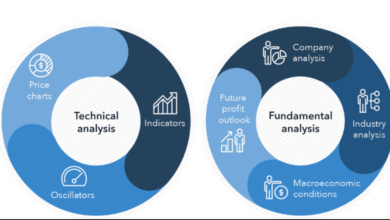
Crypto Investing Mastering Market Psychology
Understanding Market Psychology to Make Better Cryptocurrency Investment Choices is crucial for navigating the volatile crypto market. This in-depth exploration dives into the psychological drivers behind investment decisions, from the allure of quick profits to the fear of missing out. We’ll analyze how emotions, social trends, and cognitive biases influence trading activities, and provide practical strategies for making rational choices amidst market fluctuations.
This comprehensive guide will reveal how understanding human behavior in the cryptocurrency space can lead to more informed and successful investment strategies. Learn to identify patterns, manage emotions, and leverage market psychology to maximize your potential gains while minimizing risks.
Fundamentals of Market Psychology

Source: pintukripto.com
Understanding market psychology is crucial for navigating the volatile cryptocurrency landscape. Investors’ emotional responses, often driven by fear, greed, and herd mentality, significantly impact price movements. By recognizing these psychological biases, investors can make more rational decisions and potentially mitigate risk. This section delves into the key elements of market psychology in crypto, providing insights into investor behaviors and common pitfalls.
Definition of Market Psychology in Crypto
Market psychology, in the context of cryptocurrency investments, refers to the study of how human emotions and behaviors influence market trends and investor decisions. It examines how factors like fear, greed, and social influences shape investor sentiment and, consequently, the price fluctuations of cryptocurrencies.
Key Psychological Biases in Crypto Investments
Several psychological biases significantly impact investor decisions in the cryptocurrency market. These biases can lead to impulsive actions and suboptimal investment strategies. Common biases include:
- Confirmation Bias: Investors tend to favor information that confirms their existing beliefs, potentially overlooking contradictory evidence. This can lead to holding onto losing positions or missing opportunities.
- Loss Aversion: Investors feel the pain of losses more acutely than the pleasure of equivalent gains. This can lead to holding onto losing cryptocurrencies for too long or selling profitable ones prematurely.
- Anchoring Bias: Investors tend to rely heavily on the first piece of information they receive (the “anchor”) when making decisions. For example, an initial high price might lead investors to believe the price will always remain high, regardless of market conditions.
- Bandwagon Effect (Herd Mentality): Investors often follow the crowd, leading to significant price movements based on collective sentiment, rather than individual analysis.
The Role of Fear, Greed, and Herd Mentality
Fear and greed are fundamental human emotions that profoundly impact cryptocurrency markets. Fear can cause panic selling, driving prices down rapidly, while greed can lead to inflated valuations and unsustainable bubbles. Herd mentality amplifies these emotions, creating self-reinforcing cycles of price volatility. For example, during the Bitcoin bull run of 2017, the widespread belief in Bitcoin’s future value led to significant investment, and conversely, the ensuing crash was largely due to widespread fear.
Investor Personalities and Market Reactions
Different investor personalities react to market events in distinct ways. This table highlights common investor types and their typical responses to market fluctuations.
| Investor Personality | Typical Market Reaction |
|---|---|
| Cautious | Tend to wait for significant price drops before entering the market. They often seek to limit losses and prioritize risk management. |
| Aggressive | Often enter the market when prices are rising and quickly capitalize on opportunities. They are willing to take higher risks. |
| Impulsive | Driven by immediate gains and emotions. They may enter and exit the market based on short-term trends without considering long-term implications. |
Common Psychological Traps in Crypto Investing
Investors frequently fall into these psychological traps while dealing with cryptocurrencies.
| Psychological Trap | Description |
|---|---|
| Chasing Pumps | Buying cryptocurrencies during short-term price increases, often fueled by speculation or hype. |
| FOMO (Fear of Missing Out) | Buying cryptocurrencies due to the perceived popularity and potential gains, rather than individual analysis. |
| Ignoring Fundamental Analysis | Focusing solely on market sentiment and speculation instead of examining the underlying technology, utility, or project team. |
| Ignoring Diversification | Concentrating investments in a small number of cryptocurrencies, exposing themselves to significant risk. |
Understanding Behavioral Patterns: Understanding Market Psychology To Make Better Cryptocurrency Investment Choices

Source: go-pips.com
Cryptocurrency markets are notoriously volatile, and understanding the underlying behavioral patterns driving these fluctuations is crucial for making informed investment decisions. Investor psychology, influenced by news, social media trends, and market narratives, plays a significant role in shaping price movements. Recognizing these patterns allows traders to identify potential opportunities and mitigate risks.Behavioral patterns in cryptocurrency trading often manifest as herd mentality, where investors follow the crowd, leading to rapid price swings.
Fear, greed, and speculation also contribute to these dynamics. Understanding how these psychological elements impact decision-making is vital for success in the cryptocurrency arena.
Behavioral Manifestations in Cryptocurrency Trading
Investor sentiment, often influenced by social media and news coverage, can drastically impact cryptocurrency prices. A sudden surge in positive news or social media buzz can trigger a rapid increase in demand, while negative sentiment can lead to significant price drops. The interplay between these factors creates a dynamic market environment. For instance, a viral tweet about a new project can generate excitement and lead to rapid price increases, while a negative article about a company’s leadership could cause a sharp decline.
These reactions are often amplified in the cryptocurrency market due to its relative novelty and speculative nature.
Social Media and News Impact on Market Sentiment
Social media platforms like Twitter and Reddit are significant drivers of market sentiment. News articles, whether credible or speculative, can sway investor decisions. Positive news about a cryptocurrency project or a successful investment by a prominent figure can trigger buying frenzies, while negative reports can spark panic selling. This is exemplified by the dramatic price fluctuations that often follow significant news events or social media trends related to specific cryptocurrencies.
Market Narratives and Investment Decisions
Market narratives, or overarching stories about a cryptocurrency, often shape investment decisions. A narrative surrounding a coin’s potential to disrupt an industry or its role in a decentralized future can attract significant investment. Conversely, a narrative about a project’s questionable development or potential regulatory issues can deter investors. For example, the narrative around Bitcoin as a store of value, and its adoption by institutional investors, significantly influenced its price trajectory.
Similarly, the narrative around the potential of a new altcoin’s technology, or its association with a famous individual, can lead to significant price movements.
Identifying and Analyzing Price Movements
Analyzing price movements in relation to news and social media activity involves monitoring news outlets, social media platforms, and relevant forums. Tracking relevant s, hashtags, and discussions related to specific cryptocurrencies can reveal shifts in sentiment. Tools like sentiment analysis software can help quantify the overall tone of discussions, providing insights into investor sentiment. For example, a significant increase in positive comments and tweets about a cryptocurrency alongside a price increase suggests a positive correlation between social media sentiment and market movement.
Methods for Tracking and Analyzing Market Sentiment
Various methods can be employed to track and analyze market sentiment. These include:
- Sentiment analysis tools: These tools analyze text data from news articles, social media posts, and forums to determine the overall sentiment (positive, negative, or neutral). These tools often use algorithms to quantify the sentiment expressed and provide insights into potential market shifts.
- Social listening platforms: These platforms monitor conversations and discussions about specific cryptocurrencies across various social media channels. They can identify emerging trends and shifts in investor sentiment in real-time.
- News aggregators: These aggregators compile news articles related to cryptocurrencies from various sources, providing a comprehensive overview of the current market narrative. Monitoring these sources can help identify potential catalysts for price movements.
By diligently tracking these patterns and employing appropriate analytical tools, investors can better understand the psychological forces driving cryptocurrency markets and make more informed investment choices.
Impact of Emotions on Trading Decisions
Cryptocurrency markets are notoriously volatile, driven not only by fundamental factors but also by the powerful influence of human emotions. Understanding how fear, greed, and other psychological factors impact trading decisions is crucial for making rational investment choices. This understanding goes beyond the technical analysis and allows for a more nuanced approach to navigating the often-turbulent crypto landscape.Fear and greed are fundamental human emotions that frequently distort investment judgment.
These primal responses can lead to impulsive decisions, resulting in significant losses or missed opportunities. A trader driven by fear might sell off holdings prematurely during a market downturn, potentially missing out on a subsequent recovery. Conversely, greed can lead to over-leveraged positions and excessive risk-taking, exposing the trader to potential catastrophic losses. Recognizing these emotional triggers is the first step in managing them effectively.
Fear and Greed in Cryptocurrency Trading
Fear and greed are often intertwined in the crypto market, driving both impulsive selling and excessive buying. Fear can manifest as a rapid sell-off, leading to a downward spiral in prices. Greed, on the other hand, can inflate prices to unsustainable levels, creating a bubble that inevitably bursts. These emotional responses, often fueled by social media trends and news cycles, can significantly impact individual and market-wide trading behavior.
FOMO and FUD Affecting Investment Choices
Fear of missing out (FOMO) and fear, uncertainty, and doubt (FUD) are pervasive phenomena in the crypto market, influencing investment choices in significant ways. FOMO, often driven by social media hype and the perception of rapid gains, can lead to impulsive and potentially irrational investment decisions. Conversely, FUD, typically spread through misinformation or negative news, can trigger widespread panic selling, causing dramatic price drops.
Understanding how these phenomena operate can help traders avoid impulsive decisions.
Impact of Cognitive Biases on Crypto Investments
Cognitive biases are systematic patterns of deviation from norm or rationality in judgment. These biases can significantly influence investment decisions, potentially leading to suboptimal outcomes. For instance, confirmation bias, the tendency to favor information that confirms pre-existing beliefs, can lead to traders ignoring contradictory evidence or market signals. Availability heuristic, relying heavily on readily available information, can lead to overestimating the likelihood of certain events, particularly those that receive extensive media coverage.
The anchoring effect, relying heavily on initial information, can cause traders to remain anchored to an initial price point, even when subsequent data suggests otherwise.
Managing Emotional Responses During Market Volatility
Market volatility is inherent in the crypto market. Developing strategies to manage emotional responses during these periods is critical. A disciplined approach, focusing on pre-defined investment strategies and risk tolerance, can help maintain composure during periods of uncertainty. Establishing clear stop-loss orders and sticking to a predetermined investment plan can help mitigate emotional reactions to short-term price fluctuations.
Strategies for Mitigating Emotional Biases in Investment Decisions
Several strategies can help mitigate the influence of emotional biases on investment decisions. Diversification can reduce the impact of a single negative event or emotional reaction. Maintaining a long-term perspective, focusing on fundamental analysis, and understanding the underlying technology are all important factors to consider. Seeking professional financial advice and employing a disciplined approach can further mitigate the impact of emotional biases.
Understanding market psychology is key to better crypto investment choices, but sometimes, a little knowledge about natural remedies can also help. For instance, did you know that incorporating simple tips for maximizing turmeric’s healing properties, like consuming it with black pepper, can boost its absorption? This, in turn, can positively influence your approach to risk management when investing in cryptocurrencies.
Check out Simple Tips for Maximizing Turmeric’s Healing Properties for more insights. Ultimately, a holistic approach, combining market analysis with healthy habits, could be the key to making smarter cryptocurrency decisions.
Implementing a well-defined risk management strategy is essential to control emotional reactions. Maintaining a trading journal to track decisions, rationale, and outcomes can provide valuable insights into emotional patterns and improve future decision-making.
Social Dynamics and Market Sentiment
Cryptocurrency markets are significantly influenced by more than just technical indicators and fundamental analysis. Human behavior, social trends, and the ever-present chatter on social media platforms play a crucial role in shaping price movements. Understanding these social dynamics is essential for making informed investment decisions. This often goes beyond the cold hard facts and delves into the realm of human psychology and the power of collective opinion.The interplay between social media sentiment and cryptocurrency prices is a complex dance.
News, rumors, and hype can quickly spread, influencing investor decisions and causing rapid price fluctuations. This volatile nature requires a keen eye for distinguishing between genuine market signals and social media noise.
Influence of Social Media on Market Sentiment
Social media platforms have become powerful amplifiers of market sentiment. News, opinions, and analyses shared on platforms like Twitter, Reddit, and Telegram can quickly spread, influencing public perception of a cryptocurrency and its potential. Positive narratives can lead to increased buying pressure, while negative ones can trigger selling.
Examples of Social Trends Affecting Cryptocurrency Prices
Numerous instances demonstrate the influence of social trends on cryptocurrency prices. The “Dogecoin craze” of 2021, fueled by memes and viral social media campaigns, is a prime example. A surge in social media interest translated into substantial price increases, even without significant underlying changes in the coin’s value proposition. Conversely, negative news cycles, whether real or fabricated, can trigger sharp declines in prices, as seen with several projects embroiled in controversy.
The interplay between social media and price fluctuations can be complex, but it is a reality in the crypto world.
Role of Influencers and Communities in Shaping Market Opinions
Cryptocurrency influencers, often with large followings on social media, can wield considerable influence over market sentiment. Their endorsements or criticisms can significantly impact investor decisions. Furthermore, online communities, such as subreddits dedicated to specific cryptocurrencies, often act as echo chambers, amplifying both positive and negative opinions. The consensus within these communities can heavily influence wider market sentiment.
This influence is often magnified by the shared experiences and information within a community.
Distinguishing Genuine Market Signals from Social Media Hype
Differentiating between genuine market signals and social media hype is crucial for informed decision-making. While social media can indicate potential trends, it’s essential to scrutinize the underlying factors driving these trends. Looking beyond the hype and examining fundamental factors, technical analysis, and on-chain data is essential. A balanced approach, incorporating both social and fundamental analysis, can offer a more comprehensive understanding of the market.
Framework for Analyzing the Impact of Social Media on Cryptocurrency Markets
A robust framework for analyzing the impact of social media on cryptocurrency markets involves several key steps. First, monitor social media conversations surrounding specific cryptocurrencies. Identify recurring themes, sentiments, and news cycles. Second, analyze the volume and intensity of these conversations. High volume and strong sentiment can indicate potential price movements.
Third, correlate these social media signals with price movements and on-chain data. This correlation helps identify potential market signals. Finally, critically evaluate the sources of information and consider the context of the discussions.
Strategies for Utilizing Market Psychology
Market psychology plays a crucial role in cryptocurrency investments. Understanding how investors react to news, rumors, and overall market sentiment is essential for making informed decisions and mitigating potential losses. This involves recognizing behavioral patterns, anticipating emotional responses, and adapting investment strategies to capitalize on market fluctuations. Effective strategies built on a foundation of market psychology allow for more rational and successful investment choices.Successful cryptocurrency investors often go beyond just analyzing price charts and technical indicators.
They understand the underlying human motivations driving market movements. Recognizing and adapting to shifting market sentiments, assessing rumors, diversifying investments based on psychology, making informed decisions, and building resilience are all key components of this strategy. These strategies are not foolproof, but they can help to improve investment outcomes.
Recognizing and Adapting to Changing Market Sentiments
Market sentiment is a complex and ever-shifting phenomenon. It’s influenced by a multitude of factors, including news events, social media trends, and overall investor confidence. Recognizing these shifts is crucial for adjusting investment strategies. For example, a sudden surge in positive news about a specific cryptocurrency could lead to a surge in buying pressure. Conversely, negative news can trigger a sell-off.
Successful investors monitor these changes closely and adjust their portfolios accordingly. This involves continuously monitoring news outlets, social media, and relevant forums.
Assessing the Validity of Market Rumors and News
Reliable information is critical in the cryptocurrency market. Market rumors and news often spread quickly, but not all are accurate. Developing a method for assessing their validity is vital. A thorough approach includes cross-referencing information from multiple credible sources. Scrutinizing the source’s reputation and potential biases is crucial.
Checking for inconsistencies and verifying the information with independent data points are also key components of this assessment. For instance, a rumor circulating on social media should be treated with caution until confirmed by reputable news outlets or industry experts.
Diversifying Investments Based on Market Psychology
Diversification is a fundamental principle of risk management, and market psychology can inform how to diversify more effectively. For instance, during periods of high fear and uncertainty, investors might shift towards more stable, established cryptocurrencies with a proven track record. Conversely, during periods of high optimism, investors might be more inclined to invest in newer, potentially higher-risk cryptocurrencies.
A well-diversified portfolio can mitigate potential losses during market downturns. This requires understanding the risk tolerance of each investment and matching it with the prevailing market sentiment.
Making Informed Decisions Based on Market Psychology
Emotional decision-making can lead to significant investment losses. By understanding market psychology, investors can make more rational and informed decisions. Investors can reduce impulsive decisions and avoid making trades based on fear or greed by practicing mindfulness and employing strategies to manage emotions. They can also leverage established risk management strategies, such as stop-loss orders, to protect their investments during market fluctuations.
By acknowledging and addressing their emotional biases, investors can make more objective investment choices.
Building Resilience to Market Volatility
Volatility is an inherent characteristic of the cryptocurrency market. Developing resilience to these fluctuations is critical for long-term success. Establishing a well-defined investment strategy and sticking to it, regardless of short-term market movements, is key. Maintaining a balanced perspective and avoiding emotional reactions to market swings is crucial. Having a clear understanding of your investment goals and risk tolerance can also aid in navigating market volatility effectively.
By acknowledging the potential for fluctuations and adopting a long-term investment approach, investors can better withstand the inevitable ups and downs of the market.
Case Studies of Market Psychology in Action
The cryptocurrency market, driven by speculative fervor and rapid price fluctuations, is a fertile ground for observing market psychology in action. Analyzing past events, from bubbles to crashes, reveals crucial insights into investor behavior and the role of emotions in shaping market trends. Understanding these patterns can equip investors with a more informed approach to navigating the complexities of this volatile asset class.Examining historical data on market bubbles and crashes provides valuable insights into the human element within the crypto ecosystem.
This approach allows for a more nuanced understanding of the dynamics behind price movements, moving beyond purely technical analysis.
Cryptocurrency Market Bubble of 2017-2018
The 2017-2018 cryptocurrency market bubble serves as a potent example of how psychological factors can drive significant price increases. Fueled by a combination of hype, FOMO (fear of missing out), and the promise of quick riches, investors flocked to the market. The narrative of exponential growth, often amplified by social media and online communities, created a self-reinforcing cycle of optimism and investment.
This speculative frenzy led to unsustainable price valuations, significantly exceeding fundamental value metrics. The subsequent crash exposed the fragility of this speculative bubble, highlighting the dangers of unchecked enthusiasm and the critical role of emotional investment decisions.
The Bitcoin Crash of 2018: A Case Study in Investor Behavior
The sharp decline in Bitcoin’s price in 2018 exemplified how investor sentiment can shift dramatically and rapidly. Early adopters and investors initially optimistic about Bitcoin’s potential encountered a significant reversal in market sentiment. This shift, often driven by negative news, regulatory concerns, and a growing sense of disillusionment, led to a sharp sell-off. The crash exposed the vulnerability of the market to sudden shifts in investor confidence, emphasizing the role of collective emotions and the importance of diversifying investments to mitigate risk.
Psychological Biases and Project Success/Failure
Psychological biases significantly impacted the success or failure of various crypto projects. Projects that heavily relied on hype and social media promotion, often without strong fundamental backing, struggled to maintain investor interest. The appeal to fear of missing out (FOMO) and the allure of high returns frequently overshadowed crucial factors such as project development, team expertise, and token utility.
Knowing market psychology is key to better crypto investment decisions, but did you know that spices like cinnamon and cardamom can boost heart health? Recent research suggests that these aromatic additions could be surprisingly beneficial for cardiovascular well-being, much like understanding market trends can be beneficial for cryptocurrency investments. Learning about the surprising benefits of cinnamon and cardamom for heart health can offer insights into how different factors impact your choices, similar to how understanding market psychology can help you make better cryptocurrency investment choices.
The Surprising Benefits of Cinnamon and Cardamom for Heart Health. Ultimately, both areas involve understanding complex systems and adapting your strategy accordingly.
This highlights the importance of thorough research and critical evaluation of projects, rather than relying solely on hype and social media narratives.
Analysis of a Specific Cryptocurrency’s Price Action
The price action of a particular cryptocurrency can be understood through the lens of investor behavior. For example, if a coin experiences a sudden surge in price, this can often be attributed to positive news, community-driven promotion, or an anticipated regulatory event. Conversely, a sharp decline might be triggered by negative news, security breaches, or concerns about the project’s long-term viability.
Understanding the narratives and emotions behind these price movements provides valuable insights into investor psychology and potential future price trends.
Predicting Future Market Trends, Understanding Market Psychology to Make Better Cryptocurrency Investment Choices
Predicting future market trends in cryptocurrency is challenging but not impossible. By analyzing historical price patterns, investor behavior, and the prevailing market sentiment, investors can identify potential indicators of future trends. For example, a sustained period of bullish sentiment, combined with positive regulatory developments, could indicate a potential upward trend. However, it’s crucial to remember that past performance is not indicative of future results, and market psychology can change unpredictably.
Careful consideration of multiple factors, including technical analysis and fundamental research, is essential to make informed investment decisions.
Tools and Resources for Analyzing Market Psychology
Understanding market psychology is crucial for making informed cryptocurrency investment decisions. Beyond fundamental analysis and technical indicators, recognizing investor sentiment and behavioral patterns can provide valuable insights into market trends. This section details various tools and resources available to analyze these crucial aspects of the cryptocurrency market.Analyzing market psychology goes beyond just looking at price charts. It involves understanding the collective mindset of investors, their emotional responses, and how social dynamics influence trading decisions.
The right tools can help you identify potential market shifts, anticipate investor reactions, and make more calculated investment choices.
Market Sentiment Tracking Platforms
Various platforms provide insights into overall market sentiment regarding cryptocurrencies. These platforms aggregate data from various sources, such as social media, news articles, and forums, to create a composite view of investor sentiment.
Understanding market psychology is key to making better cryptocurrency investment choices, but did you know that even seemingly unrelated things like the immune-boosting properties of spices can offer insights? For example, learning how clove and black nutmeg strengthen the body’s defenses, as detailed in The Surprising Ways Clove and Black Nutmeg Boost Immunity , might actually give you a unique perspective on market trends.
Ultimately, understanding the human element in crypto is just as vital as any technical analysis.
- CoinMarketCap: CoinMarketCap offers comprehensive market data, including sentiment scores derived from news and social media activity. This can help identify potential shifts in market sentiment before they significantly impact prices.
- TradingView: TradingView provides sentiment indicators based on social media chatter, news articles, and forum discussions. It aggregates this data to offer a broader picture of the market’s mood. Users can filter by specific cryptocurrencies or overall market sentiment.
- Alternative platforms: Several specialized platforms and aggregators focus solely on cryptocurrency sentiment analysis, offering detailed reports and real-time updates on investor mood. These platforms often use algorithms to analyze large datasets, providing valuable insights into the collective emotions driving market movements.
Social Media Data Analysis Tools
Social media platforms are a rich source of information about investor behavior and sentiment. Tools exist to analyze this data, uncovering trends and patterns that might influence market direction.
- Social listening tools: Tools like Brandwatch, Talkwalker, and others are specifically designed to monitor social media conversations related to specific s or topics. They can identify recurring themes, sentiment (positive, negative, neutral), and influential voices in the cryptocurrency community, offering insights into the prevailing narrative surrounding cryptocurrencies.
- Sentiment analysis APIs: APIs designed for sentiment analysis allow developers to integrate their own data collection and analysis systems. These APIs often use natural language processing (NLP) to determine the emotional tone of text and translate it into a quantifiable sentiment score.
- Custom-built tools: Some investors develop their own tools to track specific social media channels or forums related to cryptocurrencies. These tools can be tailored to focus on specific communities or identify patterns unique to certain cryptocurrencies.
Market Psychology Indicators
Various indicators can help measure and interpret market psychology. These indicators often combine data from different sources to provide a more holistic view.
- Fear and Greed Index: This index tracks market sentiment by aggregating various data points, such as trading volume, social media mentions, and news sentiment. A high “fear” score suggests a potential market correction, while a high “greed” score might indicate an overbought market, potentially ripe for a downturn.
- Cryptocurrency News Sentiment: Tracking the sentiment of news articles related to cryptocurrencies provides valuable insights. A shift in the overall tone (from positive to negative) can indicate a potential change in investor behavior. Tools and platforms are available to analyze the sentiment expressed in news stories and social media content.
- Volume analysis: Analyzing trading volume in conjunction with price movements can reveal insights into market psychology. High volume during a price drop can indicate significant selling pressure, whereas high volume during a price surge might reflect increased investor confidence.
Utilizing Tools for Better Investment Decisions
Combining insights from different sources, such as sentiment analysis platforms, social media data, and market psychology indicators, can lead to more informed investment decisions. These tools help identify potential market turning points, understand investor reactions, and adjust investment strategies accordingly.
- Diversification: Tools can highlight periods of heightened risk aversion or exuberance. During periods of heightened fear, diversifying your portfolio can help mitigate potential losses.
- Timing investments: By observing sentiment shifts, you might identify opportunities to buy during periods of pessimism or sell during periods of excessive optimism.
- Risk management: Tools can reveal shifts in market sentiment and provide insights into potential corrections or surges. Using these tools for risk assessment can improve your investment strategy and minimize losses.
Outcome Summary
In conclusion, mastering market psychology is a vital skill for anyone seeking to succeed in the cryptocurrency market. By understanding the interplay of emotions, social dynamics, and cognitive biases, you can make more informed decisions, mitigate risks, and potentially enhance your investment outcomes. Remember, successful investing isn’t just about numbers; it’s about understanding the human element behind the market.
Frequently Asked Questions
What is the difference between fear and greed in the context of cryptocurrency?
Fear, in the context of cryptocurrency, manifests as hesitation to invest due to perceived risks or market downturns. Greed, conversely, often drives impulsive decisions based on the potential for quick profits, potentially ignoring underlying risks.
How can I identify and analyze patterns of price movements related to social media activity?
Tracking social media sentiment around specific cryptocurrencies can be a useful indicator. Look for sudden spikes in positive or negative sentiment and correlate these with price movements. However, social media is not a definitive predictor; always conduct thorough research before acting on any information.
What are some tools for analyzing market sentiment in the cryptocurrency market?
Several tools track market sentiment. Some social media analytics platforms offer data on public sentiment related to specific cryptocurrencies. Also, various websites provide metrics that aggregate information on overall market sentiment. It’s important to use multiple sources for a more complete picture.
How can I build resilience to market volatility in cryptocurrency?
Developing a diversified investment portfolio, establishing a clear investment strategy, and focusing on long-term goals can help build resilience. Avoiding emotional decisions and sticking to a plan can also be helpful.






